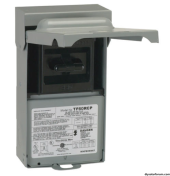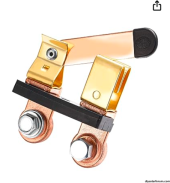I understand that AC rated switches shouldn't be used for DC, because of the difficulties extinuishing the arc with DC current. Larger air gaps are required, and if the switch fails to extinguish the arc it gets ugly.
It occurs to me that outdoor disconnects used for air conditioners and other outdoor appliances might work well. I'm talking about disconnects like this:

They funcion by having a copper blade inserted into tension contacts. A brisk pull removes the blade, instantly providing plenty of air gap. Internally, these disconnects are very similar to the classic DC blade switches, with more plastic to keep fingers away from the higher voltage:

Any comments on if its safe to use an outdoor pull type disconnect?
Code compliance is not really a factor in my situation. The county I'm in requires a basic permit for putting up my building and the only thing they care about is flood planes, setback from the roads and property lines. Nothing else is inspected (if I drilled a well or put in a sewage system, they'd inspect that).
So mostly, I'd like to know if I'm overlooking any safety concerns.
It occurs to me that outdoor disconnects used for air conditioners and other outdoor appliances might work well. I'm talking about disconnects like this:

They funcion by having a copper blade inserted into tension contacts. A brisk pull removes the blade, instantly providing plenty of air gap. Internally, these disconnects are very similar to the classic DC blade switches, with more plastic to keep fingers away from the higher voltage:

Any comments on if its safe to use an outdoor pull type disconnect?
Code compliance is not really a factor in my situation. The county I'm in requires a basic permit for putting up my building and the only thing they care about is flood planes, setback from the roads and property lines. Nothing else is inspected (if I drilled a well or put in a sewage system, they'd inspect that).
So mostly, I'd like to know if I'm overlooking any safety concerns.




